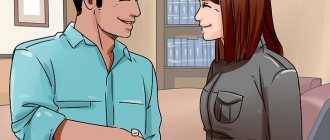For centuries, people have been trying to understand the relationship between a person’s physical appearance and his mental state. Either they believed that they had no contact with each other, or they called somatics a bridge between them. And there are also concepts for which phobias, dominant feelings, temperament, some mental disorders and other personality traits leave subtle imprints on a person’s appearance. And, if you see them and eliminate them, you can cope with many problems. Body-oriented therapy, or TOT for short, deals closely with this.
What it is
Body-oriented therapy is a direction in psychology and psychotherapy that eliminates problems and treats neuroses through various techniques of bodily contact.
The founder is Wilhelm Reich (mid-20th century) - an Austrian and American psychologist, Freud's only student. Stepping back from his teacher’s psychoanalysis and taking only a few points from it, he created his own concept of how to help people resolve difficult life situations and treat various types of mental disorders. To do this, in his opinion, it is necessary to influence in a certain way the weak “zone” of the human body that has suffered due to psychological trauma.
Over time, it turned out that working with such problem areas not only really brought calm and peace to the people coming to the session, but also significantly improved their physical well-being. Due to this, Reich gained many followers, and his therapy became widespread throughout the world.
Despite many grateful reviews, today it belongs to pseudoscientific industries, whose effectiveness has not been confirmed by research. The weakly defined theoretical evidence base that TOT actually works does not stand up to criticism either.
What to expect when meeting with a body therapist?
If you are a very rational and “earthly” person, you may be somewhat alarmed that the therapist will ask you to come to a meeting in loose clothes and will meet you not in a luxurious chair with a couch, but in a room with soft polyurethane rugs. And you may find many other people also looking around warily. In addition, the therapist, without thinking twice, can pat you on the arm or hug you.
You may be forced to do some strange exercises, stand in unusual positions, “touch” other people, draw or sing. You may be called to the center of the circle and told to dance in front of everyone, surrendering and obeying only the movements of your body.
If someone enters the hall while such a therapist is working, he will decide that another sect has begun its propaganda.
But don't let the shape fool you
. A competent specialist understands very well what he is doing. His task is to work with clamps. He may not waste time explaining. He doesn't need you to understand everything. Such a specialist works directly with unconscious processes and pressures.
After the meetings, it will be difficult for you to describe what is happening to you. But you will probably feel an incredible surge of strength, a desire to live and do something.
, and most importantly, what seemed difficult yesterday will be easy and effortless today.
If your friends ask you: “Well, what happened there?”, you will hardly be able to describe it without someone twisting your head. “I stood in the arch pose for an hour and a half” or “We roared into the dawn.” What creative “television people” don’t come up with! But, we repeat, the form should not be confusing. Know that they are professionals in their field, and your task is simply to trust them. Let them do what they think is necessary, you will feel much better.
What tasks can a psychologist give?
Such specialists do not give tasks. You won't need to practice poses or practice breathing at home. Remember, it is not the exercises themselves that work. This is not a spiritual practice, not yoga, and certainly not a sport.
. For each client, the therapist will choose his own way to remove the clamp, and everything that the specialist does to you must be done only in his presence and under his guidance.
Basics
Basic Concepts
Body-oriented therapy is based on a fundamental concept, without which this direction cannot be imagined. This is a bodily shell, although it has many other synonymous terms: muscular, muscular, characterological armor, muscle clamps, ego-defense. In total, the human body is divided into 7 problem areas, where it can form in accordance with the received psychological trauma.
According to Wilhelm Reich, the bodily shell is the body’s defenses, physically suppressing fears, internal anxiety, complexes and everything that poses a threat to the psyche.
Orgone energy is what Reich called libido, known to everyone according to Freud, which is released as a result of working with shells.
Unraveling is the name given to the process of releasing muscle tension in body-oriented therapy.
Shell formation diagram
Unlike all other areas, body therapy closely connects what is happening in a person’s soul with his appearance. According to her teaching, contact between them is established as follows:
1. Psychotrauma.
2. The specific situation associated with it is causing concern.
3. A person seeks to protect himself from this anxious state and a repetition of what happened.
4. He suppresses his fear with the help of “muscle clamps” in a certain part of the body.
5. This forms simultaneously:
- character or pattern of behavior;
- bodily shell.
An example of how this scheme works in practice:
1. At school, the child is constantly told that he is nothing.
2. He doesn’t want to go to school because of this.
3. Since this must be done day after day, he tries to avoid direct contact with the one who tells him this.
4. Does not look into the eyes, lowers his gaze, closes his eyes, wrinkles his forehead.
5. This forms:
- low self-esteem;
- body shell "Blocks in the eye segment."
Scheme of working with the shell
To help a person solve his problems, body psychotherapy works in parallel with both entities - external and internal:
- The type of bodily shell is revealed, and where exactly it is located.
- Gradually relieve tension from the problem area of the body using various techniques.
- Along the way, psychotrauma is revealed.
- Parallel work is underway with it.
- Orgone energy is released.
- Neurotic and other disorders are cured.
For a long time, within the framework of body-oriented psychotherapy, specialists worked only with muscle tension, believing that after their elimination, psychological trauma would automatically disappear. And only after a while it was concluded that it was necessary to remove both at the same time. This way you can ensure a lasting effect of the sessions and a guarantee that the problem will not return again.
How do body therapy sessions work?
The first task of a body therapist is to determine what internal problems prevent you from fully enjoying life and freely controlling your body. To do this, he identifies a problem area - an area of the body where the muscles are constantly and unnaturally tense, and there is pain. This is an indicator that allows you to understand what is troubling a person - after all, this is the reason that caused the muscle tension. When it is possible to determine the cause, a physical psychologist offers special exercises that help to re-experience the condition that caused stress in order to let it go forever. A sign that the old problem has really been released will be the body - it will relax, getting rid of tensions.
Physical contact during communication between the therapist and the patient is not necessary - its presence or absence depends on the wishes of the patient. The work can also be done verbally, without touching.
It is worth noting that touch has a high psychotherapeutic effect, but only if the patient is disposed to this form of communication with the therapist.
Methods
Based on the concept of Wilhelm Reich, various methods of body-oriented psychotherapy and approaches to the relationship between the body and psyche were created.
Basic methods of body-oriented therapy:
- bioenergy system therapy (bioenergy system therapy, BEST) E. I. Zueva: impact on the mind, feelings and body to treat the psyche;
- vegetative (somatic, bodily) therapy by W. Reich;
- movement practice of M. Feldenkrais, the goal of which is to teach a person to move correctly (like children) in order to relieve muscle tension;
- organismic psychotherapy by M. Brown: the shell is considered as a mismatch between the body and the brain;
- radix (source of vital energy) C. Kelly - a group version of body-oriented therapy;
- Rosen method M. Rosen: work with tense muscles in combination with verbal contact;
- Rolfing (structural integration) I. Rolf: work on improving gait, posture, sitting style, communication style, their relationship with behavioral patterns;
- somatic psychotherapy of biosynthesis by D. Boadella: work with 3 life streams - endoderm, mesoderm and ectoderm;
- body-oriented bioenergetic psychoanalysis (bioenergetics) by A. Lowen;
- Hakomi (body-centered psychotherapy) by R. Kurtz: the main methods are dance-movement therapy, yoga, meditation.
Partially based on body-oriented therapy are methods such as:
- Core-energy D. Pierrakos;
- biodynamics G. Boysen;
- insight therapy (bodily insight) by M. Belokurova;
- primary therapy by A. Yanov;
- process-oriented psychotherapy by A. Mindella;
- psychology of somatic development (bodynamics, bodynamic analysis) L. Marcher;
- thanatotherapy (death treatment) V. Baskakov;
- sensual (sensory) awareness Sh. Selver.
And these are not all methods. Their abundance proves the popularity of this trend.
What type of psychotherapy should I choose?
We talked only about the basic therapeutic techniques, of which there are a great many in the practice of existing correctional specialists.
Let us answer right away that there is no ideal type of psychotherapy that would be better and more effective than all others. The choice should depend on the patient’s personality, his behavior, views and beliefs, on the specific problem and on the sincere desire to solve it.
Study your goals, consult with a specialist, listen to your inner feelings. Perhaps some method will respond specifically to you, and you will enthusiastically want to try its action.
It will be important to fully understand your goals and their compliance with the capabilities of existing methods of psychotherapy. For example, cognitive behavioral therapy examines how a person's thoughts influence behavior; the client-centered method helps you independently understand your problems; the existential approach answers the main questions of life, etc.
Types of bodily shell
Despite such a huge number of techniques, almost all of them rely in their theoretical basis on those types of bodily armor that Wilhelm Reich once identified.
Ophthalmic
What's included: eyes, eyebrows, forehead, scalp.
External signs of the shell:
- feeling of a motionless mask on the face;
- shifting gaze;
- the person never makes eye contact;
- deep vertical wrinkles on the bridge of the nose and multiple wrinkles on the forehead.
Internal problems: social fears, inability to establish interpersonal contacts.
Somatics: vision problems, headaches, tearfulness.
Oral/maxillary
What's included: back of the head, chin, throat.
External signs:
- tense jaw;
- grimacing;
- habit of always chewing gum;
- “shaking nodules”;
- reticence.
Internal problems: secrecy, the need to keep everything to yourself, restrain anger.
Somatics: usually no complaints.
Throat/cervical
What's included: tongue, neck.
External signs:
- neurotic cough;
- quiet voice;
- frequent swallowing.
Internal problems: the same as with a jaw clamp, but deeper, going back to childhood (for example, resentment towards parents).
Somatics: frequent sore throats, constant lump in the throat.
Chest
What's included: chest, shoulders, shoulder blades, arms.
External signs:
- labored breathing;
- incorrect posture;
- unnatural position of the shoulders (lowered, raised, asymmetrical);
- lack of body flexibility.
This is interesting! According to body-oriented therapy, anyone can check their acquaintances for the presence of a chest shell and thereby determine whether they are happy or not. To do this, just call out to him when the person’s back is to you. If he turns his whole body, the clamp and problems are obvious. If he turns only his head or only the upper part of his body, he is fine.
Internal problems: suppression of basic human feelings - love, dreams, jealousy, hobbies. In socially oriented therapy, the chest shell is evidence that the patient is deeply unhappy.
Somatics: shoulder pain, shortness of breath, hyperhidrosis of the palms.
Diaphragmatic
What is included: diaphragm, solar plexus, lower vertebrae.
External signs:
- scoliosis;
- difficulty in exhaling.
Internal problems: prohibition on expressing feelings of disgust and disgust. Often this type of shell is observed in those who are forced to live, work or simply communicate with an unloved and even disgusting person.
Somatics: frequent vomiting, pulmonary diseases.
Abdominal
What's included: belly, back.
External signs: protruding, large belly.
Internal problems: fear of attack, anger, hostility.
Somatics: obesity, digestive problems.
Pelvic
What's included: pelvis, lower limbs.
External signs:
- the pelvis protrudes backward;
- tense buttocks;
- half-bent gait.
Internal problems: inability to satisfy arousal, suppression of sexual pleasure, feeling of threat to life.
Somatics: weak, wobbly legs, trembling knees.
What else should you pay attention to when choosing a psychotherapist?
To achieve a result, it is important not only the method that the therapist will use during the consultation process, but also your mutual sympathy and understanding - how carefully the specialist listens, accepts your problems and treats you with respect.
Another important point is the psychotherapist’s awareness of your goals and aspirations. If a specialist knows what you expect from therapy, he will have every opportunity to choose the method that is right for you to cope with your specific problem. Feel free to discuss this point if you feel that some of the proposed techniques are not suitable for you. If after this the doctor continues to insist on using his method, assures that you are resisting and are not interested in recovery, it is better to turn to another specialist.
Technicians
Working with a patient, a body therapist uses various techniques to relieve muscle tension. And some of them are familiar to everyone:
- various types of massage;
- manual therapy;
- breathing exercises;
- yoga;
- regular sets of exercises from sports programs;
- dancing;
- gymnastics for the face;
- acting skills.
In body-oriented therapy, areas of art therapy are often used. In particular, dance and drama. There are also entire sets of movement exercises developed specifically for TOT, for example, by Frederick Matthias Alexander and R. Laban.
To work with psychotrauma, conventional techniques and techniques are used, typical of all areas of psychotherapy: conversation, group trainings, affirmations, hypnosis.
Art therapy
In itself, it is not a separate direction. This is a set of techniques used by psychotherapists of different specializations; they are united by the goal of self-knowledge not through words and conversations with a therapist, but through self-expression in art. The creative process helps to recognize suppressed emotions and express difficult feelings (eg, pain, aggression).
The difference between art therapy and ordinary drawing, singing or acting circles is that the therapist views the fruits of creativity not as something separate, but as a reflection of the client’s personality and his difficulties. The works are not subject to criticism or evaluation, because the main condition of therapy is the acceptance of any constructive self-expression.
On practice
Body-oriented therapy is used to treat various personality and behavioral disorders and to eliminate psychological problems. In particular - neuroses, stress, post-traumatic disorders, depressive states, psychosomatic diseases. Let's give a few examples of how this works in practice.
For children
Body-oriented therapy is useful for children who have already encountered stress in their lives, are characterized by increased anxiety, autism, shyness, and cannot control their emotions and actions. TOT allows them to normalize their mental state, helps them calm down, get rid of emotional excitement and psychological trauma, increase their level of awareness, and survive negative life experiences.
Despite the simplicity of many exercises, specialists should work with children.
There are several universal exercises that will help relieve your child of muscle tension throughout the body.
- "Doll Soldier"
Task No. 1 is to stand up straight, tensing all parts of the body, pretending to be a soldier. Stand without moving for several minutes (depending on the age of the child). Task No. 2 is to sharply relax the body and become a rag doll without bones for a while. These positions need to be changed 2-3 times. Perform 2-3 times a day.
- "Seed"
The child curls up in a low squat and pretends to be a seed planted in the ground. The specialist pretends to water it, dig it in, care for it, and look after it. From time to time, an adult notes that the plant has grown, it has leaves, a bud, a flower. According to his story, the child slowly straightens his body.
When working with children, TOT also uses fairy tale therapy, breathing exercises, role-playing games, and group trainings.
For women
Body-oriented therapy is simply necessary for women because, in addition to mental and physical health, it provides beauty and youth to the body. Now many TOT centers are opening special courses for this. Work is carried out with all segments, regardless of whether there is a shell there or not:
- ophthalmic – cleansing the eyes and eliminating wrinkles on the face;
- oral - the ability to control your speech organs so as not to talk idle talk;
- throat/neck – the ability to express one’s emotions through singing;
- chest - development of straight posture, improvement of heart function;
- diaphragmatic - mastering breathing exercises;
- abdominal - cleansing of the gastrointestinal tract, correction of the waist and sides;
- pelvic – working with maternal instincts, reproductive functions, and one’s own orgone energy.
Body psychotherapists promise to turn any woman with the deepest complexes into a real queen in just 10 sessions (each lasts about 2 hours).
Why understand the types of psychotherapy?
The term “psychotherapy” implies a huge number of areas, approaches and methods, starting with individual conversations and ending with games, dances and tests. All techniques help to explore human emotions and find a route to improving life.
Today, many turn to specialists for help or at least think about such a step. However, it is not so easy to choose: some therapists work with couples, and some with families or groups of people, some with children and adolescents, and some with adults, and there are so many directions themselves, that it's easy to get confused. Friends can recommend a good doctor who cured them of depression, but your situation is most likely completely different. The experts themselves most often suggest using only those methods that they practice. And people ask a logical question: what exactly will help me?









